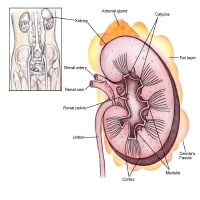Kidney Anatomy
The kidneys are paired retro peritoneal structures that are normally located between the
transverse processes of T12-L3 vertebrae, with the left kidney typically
somewhat more superior in position than the right. The upper poles are
normally oriented more medially and posteriorly than the lower poles.
The
kidneys serve important functions, including filtration and excretion
of metabolic waste products (urea and ammonium); regulation of necessary
electrolytes, fluid, and acid-base balance; and stimulation of red
blood cell production. They also serve to regulate blood pressure via
the renin-angiotensin-aldosterone system, controlling reabsorption of
water and maintaining intravascular volume. The kidneys also reabsorb
glucose and amino acids and have hormonal functions via erythropoietin,
calcitriol, and vitamin D activation.[1]
The kidney anatomy is shown in the image below.


Comments
Post a Comment